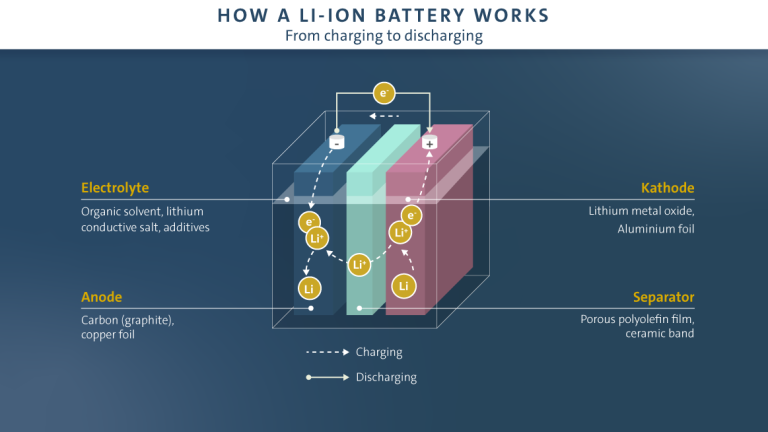Introduction
Lithium battery technology has revolutionized energy storage and is critical in various applications, including consumer electronics, electric vehicles (EVs), and renewable energy storage. As demand for more efficient, durable, and safer batteries increases, significant advancements in lithium battery technology are emerging. This article explores the latest technologies in lithium battery development, focusing on solid-state batteries, lithium-sulfur batteries, lithium-air batteries, and advanced electrode materials.

Solid-State Batteries
Overview
Solid-state batteries replace the liquid or gel electrolyte found in conventional lithium-ion batteries with a solid electrolyte. This change addresses several issues associated with traditional batteries, such as leakage, flammability, and limited energy density.
Advantages
- Safety: Solid electrolytes are non-flammable, significantly reducing the risk of thermal runaway and fires.
- Energy Density: They offer higher energy density, which translates to longer battery life for devices and greater range for EVs.
- Durability: Solid-state batteries have a longer lifespan due to reduced wear and tear on the battery components.
Challenges
- Manufacturing Complexity: Producing solid-state batteries at scale remains challenging due to the need for precise manufacturing techniques.
- Cost: Currently, these batteries are more expensive to produce than traditional lithium-ion batteries.
Lithium-Sulfur Batteries
Overview
Lithium-sulfur (Li-S) batteries use sulfur as the cathode material, which is abundant and low-cost. These batteries promise significantly higher energy densities compared to conventional lithium-ion batteries.
Advantages
- High Energy Density: Li-S batteries can potentially offer up to five times the energy density of lithium-ion batteries.
- Cost-Effectiveness: Sulfur is more abundant and cheaper than cobalt, commonly used in lithium-ion batteries.
- Environmental Impact: Using sulfur reduces the reliance on cobalt, which has associated ethical and environmental concerns.
Challenges
- Cycle Life: Li-S batteries tend to suffer from a shorter cycle life due to the dissolution of polysulfides during cycling.
- Stability: Improving the stability and performance of Li-S batteries under various conditions is an ongoing area of research.
Lithium-Air Batteries
Overview
Lithium-air (Li-air) batteries use oxygen from the air as the cathode, creating a much lighter and theoretically more energy-dense battery.
Advantages
- Energy Density: Li-air batteries have the potential to achieve energy densities comparable to gasoline, making them ideal for EVs and portable devices.
- Weight Reduction: By using oxygen from the air, these batteries can be lighter than conventional batteries.
Challenges
- Oxygen Management: Managing the intake and outflow of oxygen while preventing moisture and contaminants from entering the battery is complex.
- Cycle Life and Efficiency: Li-air batteries currently face challenges related to cycle life and efficiency, with significant losses in performance over repeated cycles.
Advanced Electrode Materials
Silicon Anodes
Silicon anodes have attracted significant attention due to their high theoretical capacity compared to traditional graphite anodes.
- High Capacity: Silicon can store much more lithium, potentially increasing the battery’s capacity and energy density.
- Challenges: Silicon expands and contracts significantly during charging and discharging, leading to mechanical stress and degradation of the battery over time. Researchers are exploring ways to mitigate this issue, such as using silicon nanostructures or composite materials.
Graphene
Graphene, a single layer of carbon atoms arranged in a hexagonal lattice, offers unique properties that can enhance lithium battery performance.
- High Conductivity: Graphene’s excellent electrical conductivity improves the efficiency and power output of batteries.
- Mechanical Strength: Its mechanical strength and flexibility can enhance the durability and lifespan of batteries.
- Challenges: The production of high-quality graphene at scale remains expensive and technically challenging.
Nanotechnology and 3D Architectures
Overview
Nanotechnology and 3D architectures are being explored to improve the performance and longevity of lithium batteries.
Advantages
- Increased Surface Area: Nanostructured materials provide a larger surface area for electrochemical reactions, improving battery performance.
- Enhanced Stability: 3D architectures can provide better mechanical stability, reducing the degradation of battery materials over time.
Challenges
- Complex Manufacturing: Developing and integrating nanostructured materials and 3D architectures into batteries involve complex and costly manufacturing processes.
Future Prospects
Integration with Renewable Energy
Advancements in lithium battery technology will play a crucial role in the integration of renewable energy sources. High-capacity, durable batteries can store energy from intermittent sources like solar and wind, ensuring a stable and reliable power supply.
Electric Vehicles
The development of high-energy-density and fast-charging batteries will accelerate the adoption of EVs by addressing range anxiety and reducing charging times. Emerging technologies like solid-state and Li-air batteries are particularly promising for next-generation EVs.
Consumer Electronics
In consumer electronics, improved lithium batteries will lead to longer-lasting devices with shorter charging times, enhancing user convenience and experience. The continued miniaturization and enhancement of battery technology will support the development of more advanced and compact electronic devices.
Conclusion
Emerging technologies in lithium battery development are poised to revolutionize energy storage across various applications. Solid-state, lithium-sulfur, and lithium-air batteries, along with advancements in electrode materials and nanotechnology, promise significant improvements in energy density, safety, and durability. While challenges remain in terms of manufacturing complexity, cost, and stability, ongoing research and innovation continue to push the boundaries of what is possible in lithium battery technology. These advancements will play a pivotal role in the future of energy storage, powering the next generation of electric vehicles, renewable energy systems, and consumer electronics.

